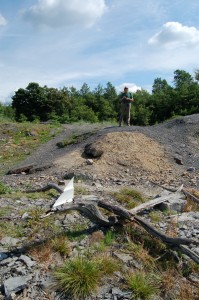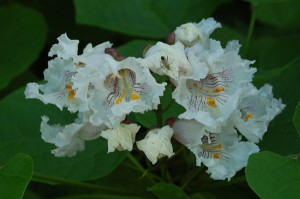
Heron’s Eye Communications traveled to Centralia, PA on June 23 to honor the resiliency of that deeply wounded place by holding a Global Earth Exchange.
We built a heron from materials found there—dead tree limbs, rocks, grasses, broken mirror shards and vinyl siding. As we worked, two young men—Nick and Billy—stopped by. We explained what we were doing. Both were positive and receptive.
The bird rests atop an area that continues to smolder from a mine fire that began in 1962 and continues today, resulting in the abandonment of the town more than 1,000 people called home.
Today, less than 10 people reside in Centralia and they, too, will have to leave. With roots in the coal region ourselves, we feel a connection to this searing loss of place and empathy for the people and for the wounded landscape.
We positioned our bird to point in the direction of a line of windmills to recognize the juxtaposition of two very different forms of energy. Before building the bird, we walked the nearby stretch of route 61 that is permanently closed to traffic due to the development of a large fissure resulting from the fire.
“Welcome to the Graffiti Highway” was one of the first messages to greet us, followed by countless graphic expressions that ranged from insightful to disturbing.
While visiting Centralia in 1997, we saw a falling-apart sign bearing painted flames and the words, “Mine Fires, Centralia’s Future,” leaning tired against a tree. Only steps away, the steamy smoke seeped from fissures in the ground. Nearby, a vacant white church stood sentinel, but asleep, its window-eyes boarded up with wooden lids.
We walked around, breathing the biting stench of the fumes. Beer bottles littered the landscape, an ongoing insult to an already-injured place. A borehole pipe, stoppered with the remnants of someone’s old shirt topped off with a rock, displayed the words, “Open to see hell on earth.”
Puffs of smoke drifted off the hillside and stitched through the stark chaos of charred tree-sticks that are victims of the sleepy mutilating giant below. Stranger still is the gridwork of streets outlining the skeleton of a once-living community. Most of the abandoned homes have been removed, purged as it were, from this smoldering landscape of broken dreams, gated graveyards and the coal mine’s gray breath.
Centralia’s wounds are evident in nearly every direction one looks, but we also saw expressions of great beauty as nature works at reclamation. Catalpa trees were in full bloom and their stunning blossoms and exotic fragrance were restorative on many levels. And there were birds, many birds, including a gnarled heron gazing toward a different future.
Visit Heron’s Eye on Facebook to see more photos of our Earth Exchange in Centralia.
[Photos © Heron’s Eye Communications.]





